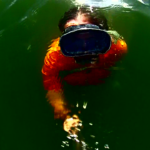I Demand a Lakewalk
Retired engineer and geologist David Hoag wrote in a Jan. 22 Duluth News Tribune op-ed piece that he feels, “It would be much better to retreat,” than to “shore up, harden, and improve the lakeshore in areas near the Lakewalk and Brighton Beach that were battered by recent storms.”
Retreat to where? Are we going to let the lake have the rail line, and Fitger’s? Are we going to cede Canal Park to the lake? Are we going to abandon all infrastructure because it needs fixing? Are we going to tear down the bridge and the canal and move them to higher ground? Set fire to the ports? Should we flood the highway and designate it “boats only”? Is Leif Erikson Park to be abandoned to the waves, and we’ll just watch as it crumbles? Should we watch as Lake Superior undermines and claims the Rose Garden? Are our Park Point citizens to be forgotten?
Some of this is for the insurance industry and the tax rates to sort out. Waterfront property should be more expensive. But: what is the plan of the retreaters? Hoag is skimpy on the details. In fact, he says, “Engineers can provide industrial designs to fix industrial problems, and this will be necessary for the seawalls within the harbor.” In other words, Hoag is fine with protecting private corporate interests. You know, “industry.” But for the public space of the Lakewalk where families teach their children about the joys of nature? It is there he wants to “save millions of dollars.”
It’s easy to say “retreat” when the lake is at your doorstep. But the lake has always been at Duluth’s doorstep. Hoag says, “It may not be a good idea to build there — nor try to fix, correct, or improve there … Let’s preserve these areas and not try to ‘improve’ them.” How is the city to preserve these areas, besides what we are already doing? Hoag bemoans “constructing concrete seawalls and placing large amounts of rip rap [piles of boulders] along the lakeshore … turn(ing) these parks into industrial real estate. Gone could be the natural rock outcrops and the beach of gray and red cobbles.” That’s exactly correct – the lake is eating the shore. Hoag wants to somehow leave the rock outcrops and red cobble beaches that the lake is inevitably reclaiming. Yet he decries the very attempts to slow erosion for the sake of public enjoyment.
In his view, as I understand it, the public must give up a stable Lakewalk, but the harbor industries can benefit from the same fixes he denies to the children and the dog-walkers. Hoag: “Why not design and build a boardwalk that can be easily repaired or replaced when damaged by storms?” Like wooden planks? We already have those. The issue is that the lake is undermining the ground those wooden planks are on. Look at the cliff erosion just up the shore from Fitger’s. Look at the solid basaltic rock outcrops known as “the Ledges” – the rock beach below the Perkins on London Road. The lake has visibly eroded this beach of solid rock in the past ten years. Water exploits and widens hairline cracks in the rock, eventually calving off large boulders that get sucked into the deep. The process is plain, and is occurring along the entire North Shore. I agree we should not build businesses and homes right on the shore any more. But how to “preserve” it? What is his solution? I submit the retreaters have no solution, or Hoag would have put it forth in his brief op-ed which, to me, reads as glib.
The breakwater walls in place before the canal was dug were wooden cribbing weighed down by rocks: 19th century technology, sticking right out in the lake, facing the direct force of the waves. The fact that the lake ate them, and the hubris of those generations, was a lesson that needed to be learned. The canal provided an infrastructure leap: a path into a protected, 20th century space. Now climate change prods us and our technological fixes again.
In fact, as Hoag recognizes, we will need changes to keep a stronger, angrier, less predictable lake at bay. But bemoaning the Lakewalk fixes as “industrial” is unproductive. Duluth is not to blame for the global crisis of climate change. If it takes driving iron walls into the lakebed, and shoring them up with concrete and tons of boulders, you can go ahead and complain that the city should save money and “retreat,” whatever that means. I don’t think it means anything. Hoag says we should retreat, while also saying we should have a cheap Lakewalk maintained on top of eroding bedrock, that we should not shore up. It makes no sense. It is a laissez faire fantasy that basically assumes a static shoreline. Again: I have personally witnessed erosion of the solid rock shoreline on a relatively short timescale. It is not “easily repaired or replaced.” Hoag speaks as a retired engineer and a geologist, I would think he should know this.
Generations of unmitigated, worldwide carbon release has pushed the lake ever higher. Do not blame city officials for trying to keep a safe, well-lit path for strolling by the waters — the city should be praised for its efforts.
I’ve heard grousing about material expenses. In fact, the Lakewalk has always been made of replaceable materials, and is worlds ahead of where Duluth’s wooden breakwaters were in the 19th Century. The issue is the retreat of the shoreline itself.
The retreaters are heading for the hills with their hair on fire, crying about the money for honest laborers to fix the problem. The Lakewalk is not made of gold plating or diamonds. It is made of labor and wages which get paid back into the community. I frankly think the debate is ridiculous.
On the real, it’s a debate we should have as the century progresses, and maybe in fifty to a hundred years the lake will have eaten Fitger’s and Canal Park and Park Point. Park Point is the real trouble spot if you ask me. But as of right now, we are talking about shoring up the Lakewalk. And this is being done with an eye toward making it last under adverse conditions that Hoag is seemingly not taking into account. It is being handled responsibly, and difficult choices are being made, and I support the Mayor and the city for this project.
When I moved to Duluth in 1998, the Lakewalk was a more recent development. And I have never heard a cross word about this city treasure. It is truly a great draw to town, a magnet for all. I walk the Lakewalk almost every day, along with other green-minded citizens, lovers, students of the beauty of light and water, and happy children. I demand a Lakewalk.
Even as the century unfolds, with new challenges and a changing lake boundary — let’s say the lake creeps up and permanently floods and conquers downtown, turning Duluth into a Northlandic Atlantis, disintegrating the hillside over the decades — I will still demand a Lakewalk. No Lakewalk? Don’t be daft. Let’s not forget that, nationally, infrastructure spending and tax rates on the rich are at historical lows. But we can’t afford to do it? Who can’t afford it? The Donald Trumps and related Boomers who have left us this mess?
Let’s be clear: the current fixes to the Lakewalk are a retreat. We are losing cute little sections of prized agate-picking and beach. That is the harsh reality, the wages of climate change. For Hoag and the retreaters to say, “Well that’s unacceptable, just forget it,” is precipitous. We are protecting what we can, and building to last to the extent we can. I applaud these efforts.
Maybe the day will come when a great tidal wave will wash Duluth into the sea. I for one will be watching that tidal wave approach from the Lakewalk. That is the day you may pry the Lakewalk from my cold, dead hands. The edge of the lake is the wilderness, and I will be prowling its changing nooks and crannies until I die. The value of the Lakewalk is whatever access it affords to our inland sea. It defines us. I demand a Lakewalk.
Change is inevitable. Climate change is inevitable. The human race might indeed be doomed. The science has been clear on this my entire life. Climate change is so great a challenge that we may not be able to persevere. But to live here, now, is to coexist with Lake Superior, who will do what she will like an angry goddess. On geologic timescales, the lake is not considered a permanent feature of the landscape — no lake is. In an indescribable future, there is no lake and maybe no people either. Until that time, I am committed to haunting the water’s edge and exploring its hidden spaces.
In the 1980s, when Canal Park was an industrial junkyard wasteland, the idea of a Lakewalk was decried as ridiculous by stodgy, conservative voices — “It’s not the city’s job to build and maintain a lakewalk” — I read that sort of thing once somewhere in a history of the construction. The Lakewalk has proved them wrong for a generation. It has proved its worth.
Whatever the changing borders of our modern perch on the world’s largest lake, our proximity to Lady Superior alone demands we must manage where its edge intersects with us — even if there were no Lakewalk. We are a city on a lake. We cannot just ignore the changing lake/city boundary.
Responsibility demands we mitigate inevitable natural erosion. All cities on water must do this. Unless your plan is to let Fitger’s fall into the water, something must be there: some wall or pile of boulders or both, and it will have to be periodically managed. There is no reason to not have a means of strolling the lakeside, on top of the berms and breakwaters and rocks. We can afford it, and I for one do not wish to live without it. The Lakewalk is among the greatest jewels in the city’s crown, and Duluth is one of the greatest jewels in Lake Superior’s diadem of cities.
As a nation, we have let infrastructure crumble, as if investment is not a sound strategy toward the future. Meanwhile, the nation’s billionaires — living on the interest of their investments — have decried attempts to be taxed at previously reasonable levels. This has deprived the public coffers of sensible investment choices since Eisenhower’s time. A Lakewalk is one of those sensible investments. Political will must be strong in the coming hard times. I refuse to abandon the Lakewalk every time the lake chews it up some. That is going to keep happening, and the waterfront and the beaches have been chewed up since time immemorial. Duluthians have always bounced back by rebuilding stronger and better and smarter. I agree with the city and with Hoag that retreat makes sense at Brighton Beach, where we have room to re-situate the road. But we do not have room to re-situate the Lakewalk. Retreat to where? Hermantown?
The case of Fitger’s is illustrative, for there we have retreated as far as we can go. Downtown Duluth is practically right on top of Lake Superior. The solution is not retreat. The solution is to do just what we are doing: build a better Lakewalk, and commit to fixing it when Lake Superior flexes her muscles again. Hoag’s vision of a cheaply maintained Lakewalk, somehow suspended over an eroding shoreline that we can ignore, is simply not credible. His point of view as a retired engineer is in conflict with the working engineers who have been tapped for the current improvements. Let them debate each other; I know who will win.
I cannot imagine a more beautiful sight than Lake Superior in her glorious changes, from fury to tranquility and back again. I intend to scry those mysteries from as close as I can get. That is why I demand a Lakewalk. I will not countenance a blind fealty to retreat when we, the richest nation in the world, have yet to address our infrastructure problems in these dark times. Nationally, we let our roads and bridges fall apart because our politics have been captured by the lickspittles of the one percent. Retreat my ass. I demand a Lakewalk.
-All my essays here.
Recommended Links:
Leave a Comment
Only registered members can post a comment , Login / Register Here















6 Comments
David Beard
about 4 years agoJim Richardson (aka Lake Superior Aquaman)
about 4 years agovicarious
about 4 years agoDave Sorensen
about 4 years agoDavid Beard
about 4 years agoDavid Beard
about 4 years ago